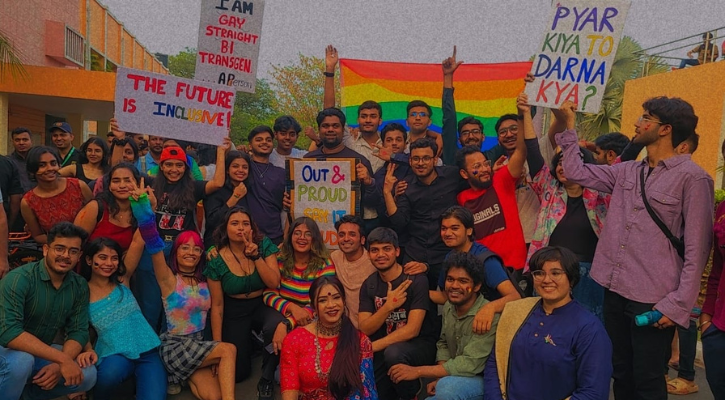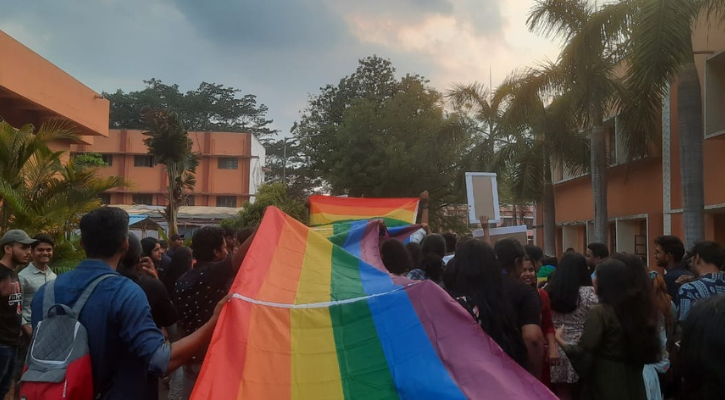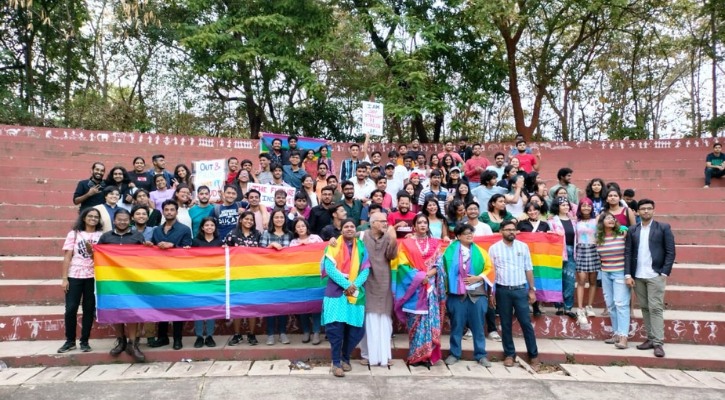Housing, mental health resources, and community support: Queer collectives on college campuses are empowering students to ask for all of this and more.
“I come from a small town in Chhattisgarh called Korba. Before entering university, I didn’t know that being gay was a possibility,” says Monidipa Sengupta, a 28-year-old law student.
When Monidipa was in her second year of university studies at the Hidayatullah National Law University in Raipur, she realized that she was pansexual. The catalyst? Getting to know her law school seniors in the queer collective on campus.
indiatimes
jump to
![]()
- The value created by queer collectives
- How do these groups work?
- Fighting stigma on campus
The value created by queer collectives
University queer collectives in India have been around for years, decades in some cases, and are becoming increasingly common, formed in response to the needs of students like Monidipa.
In 2021, 4.1 crore students enrolled in higher education in India, according to the All India Higher Education Survey report published in January 2023 by the Ministry of Education, Government of India.
In September 2018, the Supreme Court of India struck down Section 377 of the country’s penal code which effectively criminalized homosexuality. The Transgender Persons (Protection of Rights) Act 2019 also prohibits acts of discrimination against the transgender community, specifically mentioning discrimination in educational institutions.
Also Read: Resilience and Glamour: Revealing the Tapestry of Indian Drag Queens
But a pervasive stigma against these communities persists at a social and institutional level. A 2021 study of higher education students by IIM Ahmedabad, the Boston Consultancy Group and Diversity and Inclusion consultancy Pride Circle suggested that a staggering 64% of respondents who self-reported as being from the queer community face outright discrimination. .
 indiatimes
indiatimes
Recent marriage equality hearings also showed that the government has opposed giving same-sex couples the full range of rights available to Indian citizens.
In this situation, college collectives are a haven for people from gender and sexual minority communities, allowing them to access support, resources, knowledge, and bargaining power to secure accommodations such as gender-neutral bathrooms and shelters. .
Shivam Sharma is a fourth-year college student at the National Academy of Legal Studies and Research (Nalsar) in Hyderabad. He is also a member of the college’s queer collective.
“When I arrived on campus, my elder Kranthi, who is a transgender person and founder of the collective, helped me get gender-neutral housing for me,” says Shivam. “We secure the ground floor of the girls’ hostel for anyone who prefers that type of accommodation.”
Shivam is now part of the formal Committee that is helping to frame the University’s policies for people from gender and sexual minority groups, just like Kranthi. This comes after the institution announced in 2022 that it would become a gender-neutral campus, thanks to the efforts of the collective.
How do these groups work?
Not all groups work the same way. Some of them have central or executive committees with jobs in addition to the general members, while many others prefer to operate in a more decentralized way, with the help of volunteers.
In many cases, multiple collectives have formed after the old ones went dormant once their founders graduated. The pandemic hit these groups particularly hard: With fewer students coming to campus, there was no chance to come together like they used to.
 indiatimes
indiatimes
But as campuses return to full-time operation, these collectives are coming back to life, with pride marches, fundraisers, meetups and sharing circles some of the community events they are focusing on.
Also read: Quest For The West: Why do queer Indians want to move?
“We just held our flagship event, a discussion session with queer speakers and a pride parade, during our college festival in March,” says an official from the Rainbow Dot Club, the queer collective of NIT Rourkela, who requested anonymity. “It was a great success, with almost 200 students from both our institution and others participating, but it took us six months to get permission from the university administration for the event, despite being formally recognized as a student club. ”.
Not all collectives are registered with their university authorities as officially sanctioned campus groups. Being registered comes with its own set of problems; often requires the maintenance of an official membership register, which can mean that people are declared members of the queer community against their will, possibly endangering their safety. But it also comes with the power to involve authorities in cases of problems like cyberbullying and bullying.
Fighting stigma on campus
In May 2023, IIT Delhi’s queer collective Indradhanu posted on their Instagram page that they had filed a police complaint against a page posting discriminatory memes against the club.
“The meme involved the use of remedial violations against members of the community,” says Varun OK, an alumnus of the institute and a member of Indradhanu. “We are working with the authorities to get closer to the Delhi police. The page has now been removed.”
This is not an isolated incident. A former official with QAGAAR, the queer collective at IIT Roorkee, has screenshots showing discriminatory comments and posts against students celebrating Pride. However, in the case of QAGAAR, members had much more trouble getting the authorities to act, partly because it is not yet officially registered as a collective.
 indiatimes
indiatimes
Both Varun and his compatriot from QAGAAR say that most of the people posting the content are students at the institution itself, indicating a greater need for awareness. Many collectives require personal references or the completion of forms to ensure that the people joining do not make the space unsafe for others.
But for some, the collectives risk perpetuating the very inequalities that exist outside of these spaces.
Also read: I am a child. I’m a girl. I’m a fag.
“As a queer Dalit student, I felt incredibly uncomfortable at first,” says Vishnu, a third-year Health Psychology student who helped found the Alliance for Sexualities and Gender at his place of study, the University of Hyderabad. “The voices of Dalit students were often drowned out in most queer circles. It was much more difficult for me to come out as a Dalit to my fellow students than it was to come out as queer.”
Vishnu’s experience was replicated in his chats with other queer Dalits, who said they felt there is a lot of class difference in queer spaces as well.
“Although we have consciously tried to create space for Dalit students in the collective, upper caste and upper class queer people have to take conscious action in this regard,” says Vishnu.
 indiatimes
indiatimes
For Monidipa, her university collective provided a kind of refuge she hadn’t experienced before, so when she arrived at her current place of study, IIT Kharagpur, she sought out Ambar, the institute’s queer group. For the 2022-2023 academic year, she was governor of the collective.
“Once, I was the student who turned to her elders for help, and now I am the person many children turn to,” she says. “This wouldn’t have happened if I hadn’t found the right queer people at the right time in my life. That is why these groups are so important”.
For more stories about the LGBTQIA+ community and homosexuality in India, keep reading Spectrum at TIT Education.
Categories: Trending
Source: vtt.edu.vn